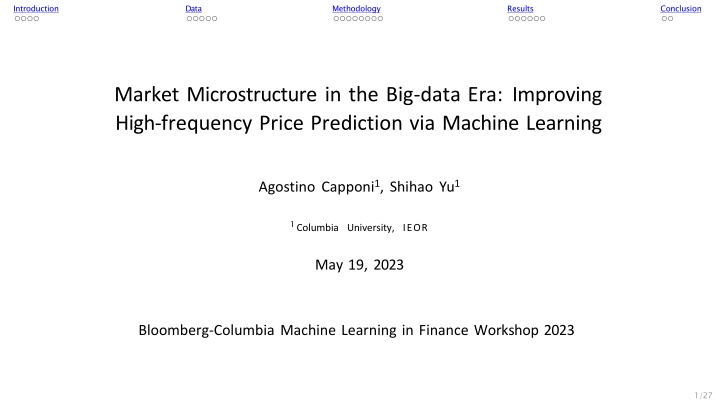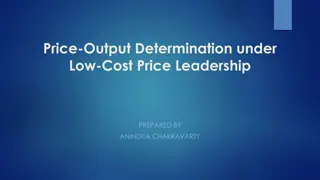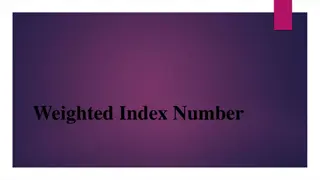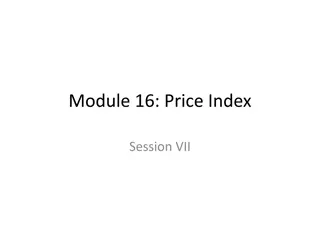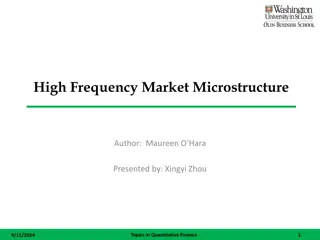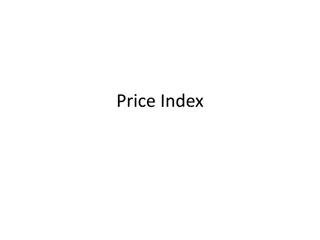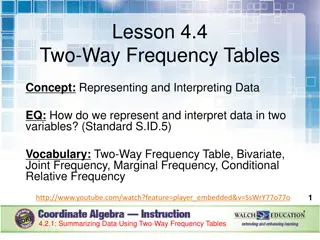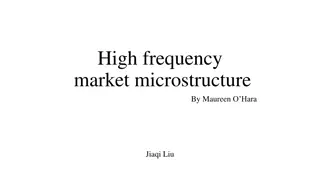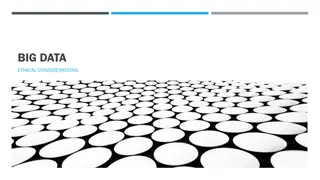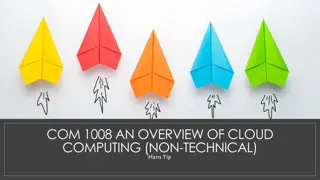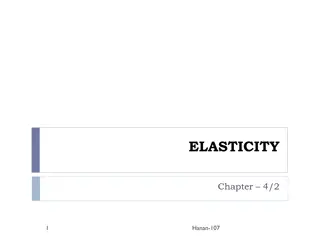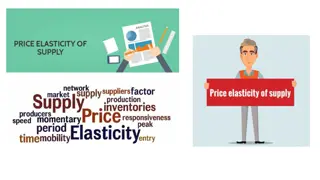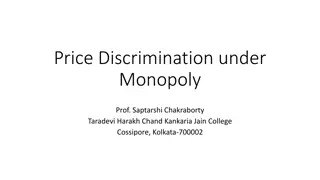Market Microstructure in the Big-data Era: Improving High-frequency Price Prediction via Machine Learning
Analyzing the impact of big data on market microstructure and high-frequency trading. Discussing the use of machine learning for accurate price prediction in fast-paced financial markets, focusing on US equities. Exploring the debate on two-tiered market data policies and the contributions of empirical microstructure literature and state-of-the-art machine learning models.
Download Presentation

Please find below an Image/Link to download the presentation.
The content on the website is provided AS IS for your information and personal use only. It may not be sold, licensed, or shared on other websites without obtaining consent from the author.If you encounter any issues during the download, it is possible that the publisher has removed the file from their server.
You are allowed to download the files provided on this website for personal or commercial use, subject to the condition that they are used lawfully. All files are the property of their respective owners.
The content on the website is provided AS IS for your information and personal use only. It may not be sold, licensed, or shared on other websites without obtaining consent from the author.
E N D
Presentation Transcript
Introduction Data Methodology Results Conclusion Market Microstructure in the Big-data Era: Improving High-frequency Price Prediction via Machine Learning Agostino Capponi1, Shihao Yu1 1 Columbia University, IEOR May 19, 2023 Bloomberg-Columbia Machine Learning in Finance Workshop 2023 1/27
Introduction Data Methodology Results Conclusion Outline Introduction Data Methodology Results Conclusion 2/27
Introduction Data Methodology Results Conclusion Outline Introduction Data Methodology Results Conclusion 3/27
Introduction Data Methodology Results Conclusion Microstructure in the machine age Big data in the US equities market Extremely fast: algorithmic and high-frequency trading; 20% of trades arrive in < 1ms clusters (Menkveld, 2018) A highly fragmented market: 16 public exchanges, internalization, dark pools Voluminous trading data: level-3 order book messages The information set of market participants has greatly expanded Market data is crucial, for market makers, arbitrageurs & buy-side 4/27
Introduction Data Methodology Results Conclusion Market data policy debate Two-tiered market data for U.S. equities: Consolidated (SIP) feeds: slow, top-of-book quotes, SEC-mandated, relatively cheap, used by unsophisticated traders Direct feeds: fast, depth-of-book quotes, sold by exchanges, expensive, used by sophisticated traders such as high-frequency traders Fair? Policy debates U.S.: NMS 1.0 (top-of-book in the SIP) NMS 2.0 (five-level depth in the SIP) Europe: Consolidated feed in the making: What to include? Top-of-book? Depth-of-book? Economic questions: Which exchange contributes the most to price discovery? Which part of the data feed contributes the most to price discovery? (Top? Within the five best levels? Full depth?) 5/27
Introduction Data Methodology Results Conclusion Contributions Empirical microstructure literature 1 Limited set of variables/features Ex-ante specification of price impact function In-sample, ex-post attribution of information shares Quantitative finance literature 2 State-of-the-art machine learning models Economics is not clear The goal of our paper: bridge the above two strands of literature 1Hasbrouck (1995) and Brogaard, Hendershott, and Riordan (2019) 2Kercheval and Zhang (2015), Tsantekidis et al. (2017), Ntakaris et al. (2019), Sirignano (2019), Zhang, Zohren, and Roberts (2019), and Wu et al. (2022) 6/27
Introduction Data Methodology Results Conclusion Outline Introduction Data Methodology Results Conclusion 7/27
Introduction Data Methodology Results Conclusion Data Directfeeds from public exchanges Level 3 order-book messages: all add (new limit orders), cancel/modification of existing orders, and trade messages Timestamped to microsecond precision 30 constituent stocks of the Dow Jones Index (DJI). 54 trading days spanning from the year of 2017 to 2021. For each exchange, we build the entire order book based on the direct feed messages 8/27
Introduction Data Methodology Results Conclusion Limit order book (LOB) market Most liquid markets use limit order books (LOBs) for trading A limit order book is essentially a collection of unexecuted quotes Each quote specifies the price and quantity the trader is willing to trade New quotes can be continuously added and existing quotes can be canceled, modified, or executed against incoming marketable orders 9/27
Introduction Data Methodology Results Conclusion LOB data types Level-I: the best bid/ask prices and volumes, Level-II: price and aggregated volume across a certain number of price levels Level-III: non-aggregated orders placed by market participants Figure 1: LOB data types. Source: Wu et al. (2022) 10/27
Introduction Data Methodology Results Conclusion Direct feeds Directfeeds examples (a) Add message (b) Cancel/modification message (c) Trade message Figure 2: Direct feeds 11/27
Introduction Data Methodology Results Conclusion Outline Introduction Data Methodology Results Conclusion 12/27
Introduction Data Methodology Results Conclusion LOB actions LOB is constantly changing due to add, modifications, and executions New quotes can be continuously added, and existing quotes can be canceled, modified, or executed against incoming marketable orders At different price levels Figure 3: LOB actions. Source: Wu et al. (2022) 13/27
Introduction Data Methodology Results Conclusion Feature engineering LOB actions and their lagged values, from each exchange Trade-BBO-Changing: Executions moving BBO Trade-NonBBO-Changing: Execution not moving BBO Add-BBO-Improving: Add orders improving BBO Cancel-BBO-Worsening: Cancel orders worsening BBO Add-at-BBO: Add orders adding depth at the current BBO Cancel-at-BBO: Cancel orders removing depth at the current BBO Add-<=5lvlBBO: Add orders adding depth < = 5 levels from BBO Cancel-<=5lvlBBO: Cancel orders removing depth < = 5 levels from BBO Add->5lvl-BBO: Add orders adding depth > 5 levels from BBO Cancel->5lvl-BBO: Cancel orders removing depth > 5 levels from BBO Midquote changes, and their lagged values, from each exchange 14/27
Introduction Data Methodology Results Conclusion Target and performance evaluation Target Short-term NBBO change (e.g. in the next 5 events) Clock runs in event time Performance evaluation Mean squared error (MSE) R2 15/27
Introduction Data Methodology Results Conclusion Machine learning models Simple linear model (OLS) Linear models with penalties Elastic net penalties Tree-based models Random forests (RF) Boosted regression trees (BRT) 16/27
Introduction Data Methodology Results Conclusion Linear model with penalties Too many features might lead to overfitting One solution is to add penalties to the loss function Elastic net penalties: penalize + shrink (1) Solves overfitting but is still linear. 17/27
Introduction Data Methodology Results Conclusion Random forests and boosted regression trees Regression tree Figure 4: Tree example. Source: Gu, Kelly, and Xiu (2020) Tree splitting captures non-linearities and flexible interactions Both random forests and boosted regression trees are ensemble methods 18/27
Introduction Data Methodology Results Conclusion Tranining, validation, and testing sample split We split each trading day into 13 half-an-hour intervals Training (system parameters fitting), validation (hyper/tuning parameters fitting), and testing based on inter-day rolling windows. For example, 09:30 - 10:00 today as training 09:30 - 10:00 tomorrow as validation 09:30 - 10:00 the day after as testing We follow the hyperparameters in Gu, Kelly, and Xiu (2020) Elastic-net: = 0.5; = (0.1, 0.01, 0.001, 0.0001) RF: Depth = (2, 4, 6); #Trees = 300; #Features in each split = (3, 5, 10) BRT: Depth = (1, 2); #Trees = (100, 1000); Learning rate = (0.01, 0.1) 19/27
Introduction Data Methodology Results Conclusion Outline Introduction Data Methodology Results Conclusion 20/27
Introduction Data Methodology Results Conclusion Prediction (MSE) Consider the five stocks: American Express (AXP), Boeing (BA), Caterpillar (CAT), Disney (DIS), and Goldman Sachs (GS).3 BRT consistently outperforms linear models in terms of MSE Table 1: MSE of different models. The bold font shows the smallest for each column/stock. ticker model AXP BA CAT DIS GS OLS Elastic-net RF BRT 0.0149 0.0149 0.0151 0.0145 0.1267 0.1206 0.1214 0.1158 0.0407 0.0368 0.0363 0.0343 0.0213 0.0213 0.0218 0.0204 0.3925 0.3808 0.3727 0.3593 3In our paper, we include results for all 30 DJI tickers. 21/27
Introduction Data Methodology Results Conclusion Prediction (R-squared) BRT consistently outperforms linear models in terms of r 2 (2) Table 2: MSE of different models. The bold font indicates the smallest for each column/stock. ticker model AXP BA CAT DIS GS OLS Elastic-net RF BRT 0.0309 0.0325 0.0202 0.0509 -0.0479 0.0229 0.0179 0.0520 -0.1429 0.0186 0.0230 0.0296 0.0448 0.0465 0.0251 0.0737 -0.0526 -0.0113 0.0148 0.0497 22/27
Introduction Data Methodology Results Conclusion Permutation importance To assess the importance of a feature or several features, permutate (randomly shuffle the ordering) them in the testing set Then compare the change in MSE or r 2 from the testing set Different from in-sample feature importance Agnostic to model choice 23/27
Introduction Data Methodology Results Conclusion Permutation importance (exchange) Which exchange contributes the most to price discovery? Look at the r 2 drops when an exchange s data feed is permutated Larger exchanges are more important. But the drop in r 2 is mild. Table 3: r 2 of permutated testing samples. The first line shows the r 2 of the original sample. The second lines and so on report the r 2 changes when an exchange s data feed is permutated. The bold font indicates the largest drop for each column/stock. ticker exchange AXP BA CAT DIS GS All exchanges NYSE ARCA NASDAQ BATS EDGX 0.0588 -0.0025 -0.0014 -0.0051 -0.0039 -0.0016 0.0649 -0.0029 -0.0008 -0.0021 -0.0011 -0.0008 0.0915 -0.0074 -0.0014 -0.0113 -0.0019 -0.0008 0.0909 -0.0044 -0.0008 -0.0194 -0.0022 -0.0001 0.0484 -0.0035 -0.0008 -0.0025 -0.0007 -0.0004 24/27
Introduction Data Methodology Results Conclusion Permutation importance (data feeds) Which part of the data feed (e.g., beyond the best five levels, or within the best five levels) contributes the most to price discovery? Look at the r 2 drop when a different part of the data feeds is permutated Data feeds beyond the five best levels have limited information; within five levels much more important Table 4: r 2 of permutated testing samples. The first line shows the r 2 of the original sample. The second lines and so on report the r 2 changes when part of the data feed is permutated. ticker lvl AXP BA CAT DIS GS All lvls beyond_5lvl (shuffled) beyond_top (shuffled) 0.0588 -0.0019 -0.0052 0.0649 -0.0028 -0.0046 0.0915 -0.0021 -0.0062 0.0909 -0.0019 -0.0084 0.0484 -0.0012 -0.0024 25/27
Introduction Data Methodology Results Conclusion Outline Introduction Data Methodology Results Conclusion 26/27
Introduction Data Methodology Results Conclusion Conclusion Machine learning models have consistently better prediction performance for LOB midquote changes than linear models From an economic perspective: Larger exchanges are more important. But the drop in r 2 is mild. Data feeds beyond the five best levels have limited information Future extensions: LOB events have time-series dynamics, e.g, autoregressive structure Suitable for time-aware machine learning models: Long short-term memory (LSTM), Transformers 27/27
